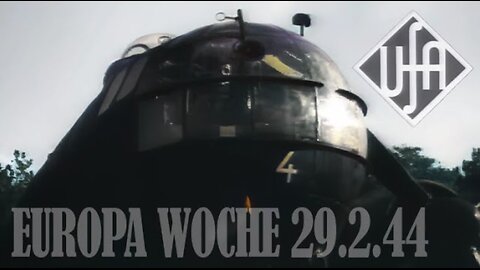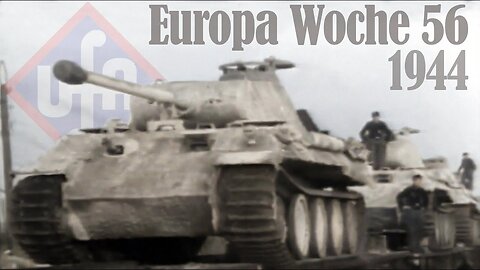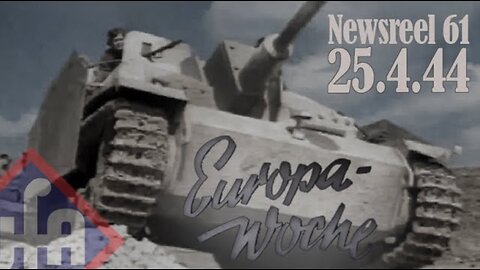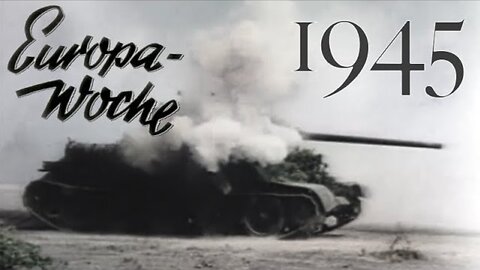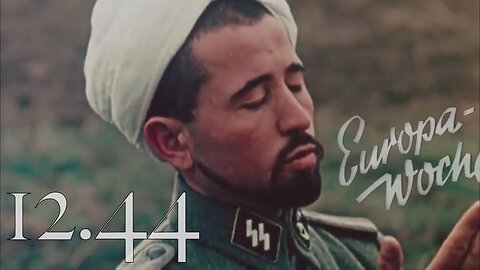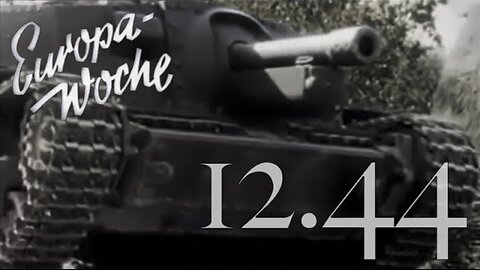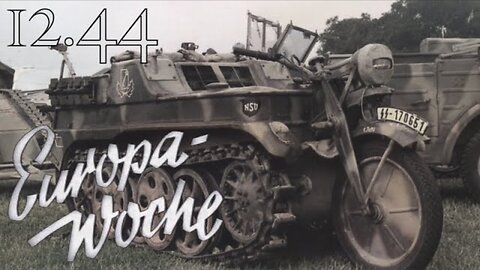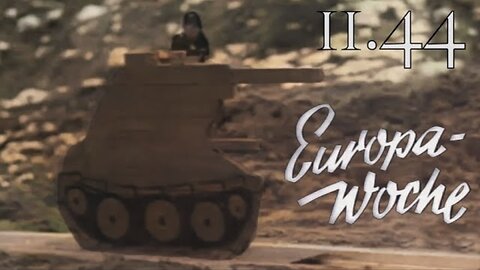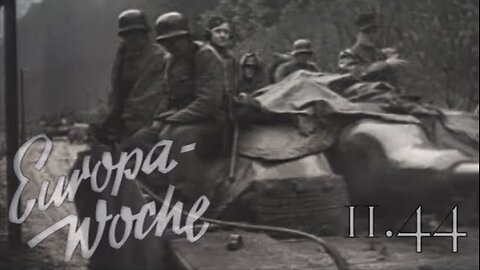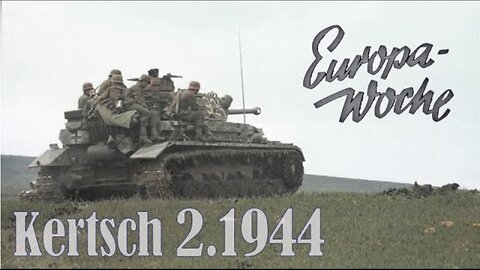
-
German Newsreel 2.1944 EUROPA WOCHE № 52 KERCH BRIDGEHEAD
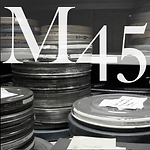 Military1945🔥PREVIEW ALL YOUTUBE VIDEOS www.Patreon.com/Military1945 Episode 286 Be sure to give this video a THUMBS UP! Best way to support the channel! Europa Woche Nr. 52 February 22, 1944 00:51 - Inauguration of Seyss-Inquart as the new President of the Germany Academy 01:42 - Report on a sawmill powered by water power 02:49 - Processing of herrings 04:18 - Performances of the Circassian dance and choir group 05:17 - German Film Ballet during training and dance rehearsal 07:26 - Four-man bobsleigh competition 08:15 - Rounding up reindeer herds in Lapland 09:24 - Celebration with young workers 10:28 - Henkell sparkling wine cellar 11:53 - German soldiers during operations against the Kerch bridgehead Battle of the Parpach Narrows, 27 February – 11 April Stavka reinforced the Caucasus Front Front with nine rifle divisions. Soviet engineers built an ice road across the frozen Kerch Strait, enabling 96,618 men, 23,903 horses and 6,519 motor vehicles to reinforce the Kerch peninsula forces. The 47th Army was deployed to the area, initially with only two rifle divisions. The Stavka created the Crimean Front under, with Kozlov as its commander, on 28 January, with the 44th, 47th and 51st Armies belonging to it organically and the Separate Coastal Army and Black Sea Fleet falling under its operational command. Kozlov had little command experience beyond the regimental level and his staff was as inept. Stavka representative Lev Mekhlis arrived at the Crimean Front HQ in late January and introduced his own ideas into the planning stage. Stalin and Mekhlis wanted to liberate Crimea with an offensive on 13 February, but the Soviet forces were unequal to the task. Soviet troops lacked food and three 76mm artillery regiments had no ammunition at all. The backward nature of the Kerch peninsula's road network, the muddy roads and the Luftwaffe's bombing campaign against ports and Soviet cargo shipping prevented a sufficient logistical buildup and made Stalin's demand unrealistic. On 27 February Kozlov finally had available for his operation the required 93,804 troops, 1,195 guns and mortars, 125 anti-tank guns, 194 tanks and 200 aircraft. These forces were assembled in nine rifle divisions at the front along with numerous tank brigades containing T-26, T-34 and 36 KV-1 tanks. The Soviets were far from ready. Their tanks and aircraft lacked fuel supplies, many weapons did not work, the Soviet artillery had not organized a fire system, communications between Kozlov's HQ and the Crimean Front armies were repeatedly cut off, and engineers had not constructed field works of any kind. Under pressure from Stalin, Kozlov started his attack anyway. First Offensive, 27 February – 3 March The 51st Army planned to attack in the north on 27 February across a flat, 80-square kilometer plain dotted only by a handful of small villages. The Germans fortified the villages of Tulumchak, Korpech’ [ru], and Koi-Asan. The German 46th and 132nd Infantry Divisions held the XXXXII Corps front along with the Romanian 18th Infantry Division. Gruppe Hitzfeld waited in reserve. The Axis defensive preparations were extensive and in accordance with German tactical doctrine. Reinforced German strongpoints had all-around defenses, neutralizing the effects of simultaneous Soviet frontal and flank attacks, and the Germans created a system of engineering works permeated with augmented artillery fires. Mattenklott made the mistake of putting the Romanian 18th Infantry Regiment into a difficult and exposed position in a salient on the northern part of the line. The Soviet planners, led by Tolbukhin, failed to account for the warm weather that turned the terrain into a sea of mud. 51st Army's offensive kicked off at 0630 hours on 27 February with a 230-gun artillery preparation of which most were light 76 mm guns and only 30 were heavy 122 mm guns. The fortified German strongpoints were largely unharmed by the light high-explosive rounds. German artillery responded with its own fire and the Soviets lacked the counter-battery capabilities to suppress them. The open terrain provided no cover for the Red Army soldiers, who were systematically killed and wounded in great numbers by incessant German artillery strikes. The heavy Soviet KV-1s sank into the mud and could not get forward. Vehicles were also stuck and Soviet artillery shells had to be carried by hand. Confused Soviet soldiers trampled their comrades to death in the mud.126 views
Military1945🔥PREVIEW ALL YOUTUBE VIDEOS www.Patreon.com/Military1945 Episode 286 Be sure to give this video a THUMBS UP! Best way to support the channel! Europa Woche Nr. 52 February 22, 1944 00:51 - Inauguration of Seyss-Inquart as the new President of the Germany Academy 01:42 - Report on a sawmill powered by water power 02:49 - Processing of herrings 04:18 - Performances of the Circassian dance and choir group 05:17 - German Film Ballet during training and dance rehearsal 07:26 - Four-man bobsleigh competition 08:15 - Rounding up reindeer herds in Lapland 09:24 - Celebration with young workers 10:28 - Henkell sparkling wine cellar 11:53 - German soldiers during operations against the Kerch bridgehead Battle of the Parpach Narrows, 27 February – 11 April Stavka reinforced the Caucasus Front Front with nine rifle divisions. Soviet engineers built an ice road across the frozen Kerch Strait, enabling 96,618 men, 23,903 horses and 6,519 motor vehicles to reinforce the Kerch peninsula forces. The 47th Army was deployed to the area, initially with only two rifle divisions. The Stavka created the Crimean Front under, with Kozlov as its commander, on 28 January, with the 44th, 47th and 51st Armies belonging to it organically and the Separate Coastal Army and Black Sea Fleet falling under its operational command. Kozlov had little command experience beyond the regimental level and his staff was as inept. Stavka representative Lev Mekhlis arrived at the Crimean Front HQ in late January and introduced his own ideas into the planning stage. Stalin and Mekhlis wanted to liberate Crimea with an offensive on 13 February, but the Soviet forces were unequal to the task. Soviet troops lacked food and three 76mm artillery regiments had no ammunition at all. The backward nature of the Kerch peninsula's road network, the muddy roads and the Luftwaffe's bombing campaign against ports and Soviet cargo shipping prevented a sufficient logistical buildup and made Stalin's demand unrealistic. On 27 February Kozlov finally had available for his operation the required 93,804 troops, 1,195 guns and mortars, 125 anti-tank guns, 194 tanks and 200 aircraft. These forces were assembled in nine rifle divisions at the front along with numerous tank brigades containing T-26, T-34 and 36 KV-1 tanks. The Soviets were far from ready. Their tanks and aircraft lacked fuel supplies, many weapons did not work, the Soviet artillery had not organized a fire system, communications between Kozlov's HQ and the Crimean Front armies were repeatedly cut off, and engineers had not constructed field works of any kind. Under pressure from Stalin, Kozlov started his attack anyway. First Offensive, 27 February – 3 March The 51st Army planned to attack in the north on 27 February across a flat, 80-square kilometer plain dotted only by a handful of small villages. The Germans fortified the villages of Tulumchak, Korpech’ [ru], and Koi-Asan. The German 46th and 132nd Infantry Divisions held the XXXXII Corps front along with the Romanian 18th Infantry Division. Gruppe Hitzfeld waited in reserve. The Axis defensive preparations were extensive and in accordance with German tactical doctrine. Reinforced German strongpoints had all-around defenses, neutralizing the effects of simultaneous Soviet frontal and flank attacks, and the Germans created a system of engineering works permeated with augmented artillery fires. Mattenklott made the mistake of putting the Romanian 18th Infantry Regiment into a difficult and exposed position in a salient on the northern part of the line. The Soviet planners, led by Tolbukhin, failed to account for the warm weather that turned the terrain into a sea of mud. 51st Army's offensive kicked off at 0630 hours on 27 February with a 230-gun artillery preparation of which most were light 76 mm guns and only 30 were heavy 122 mm guns. The fortified German strongpoints were largely unharmed by the light high-explosive rounds. German artillery responded with its own fire and the Soviets lacked the counter-battery capabilities to suppress them. The open terrain provided no cover for the Red Army soldiers, who were systematically killed and wounded in great numbers by incessant German artillery strikes. The heavy Soviet KV-1s sank into the mud and could not get forward. Vehicles were also stuck and Soviet artillery shells had to be carried by hand. Confused Soviet soldiers trampled their comrades to death in the mud.126 views -
German Newsreel 29.2.44 EUROPA WOCHE Nr. 53
 Military1945🔥SUPPORT THE CHANNEL and get access to exclusive film footage www.Patreon.com/Military1945 Episode 203 EUROPA WOCHE Reel 53 29th Feb. 1944 1:11 - Preparation for a bombing raid on London 3:25 - German boys choir in Budapest 4:33 - German soldiers with sled dogs in Lappland 5:18 - Final game in the German hockey league 6:38 - Motorcycle acrobats 7:36 - Tennis match in Spain 8:29 - Production of children's toys 9:14 - Romanian general 10:29 - German S-Boats in action SUBSCRIBE https://www.youtube.com/channel/UCN2UQVe6Xaqz5rLFaWq8-mw?sub_confirmation=1 As the name of the weekly news series implies, Europa Woche was created for an international audience, specifically for populations in German occupied and allied countries. The content was carefully orchestrated mixing military themes showing the superiority and success of German arms and light hearted segments focusing on cultural and leisure activities. Reel 53 in the series was released on February 29, 1944. #DeutscheWochenschau #worldwar2 #GermanNewsreels #Goebbels #GermanPropaganda #Monatsschau #Blitz #EasternFront @Military194546 views
Military1945🔥SUPPORT THE CHANNEL and get access to exclusive film footage www.Patreon.com/Military1945 Episode 203 EUROPA WOCHE Reel 53 29th Feb. 1944 1:11 - Preparation for a bombing raid on London 3:25 - German boys choir in Budapest 4:33 - German soldiers with sled dogs in Lappland 5:18 - Final game in the German hockey league 6:38 - Motorcycle acrobats 7:36 - Tennis match in Spain 8:29 - Production of children's toys 9:14 - Romanian general 10:29 - German S-Boats in action SUBSCRIBE https://www.youtube.com/channel/UCN2UQVe6Xaqz5rLFaWq8-mw?sub_confirmation=1 As the name of the weekly news series implies, Europa Woche was created for an international audience, specifically for populations in German occupied and allied countries. The content was carefully orchestrated mixing military themes showing the superiority and success of German arms and light hearted segments focusing on cultural and leisure activities. Reel 53 in the series was released on February 29, 1944. #DeutscheWochenschau #worldwar2 #GermanNewsreels #Goebbels #GermanPropaganda #Monatsschau #Blitz #EasternFront @Military194546 views -
German Newsreel 21.3.44 EUROPA WOCHE 56 - 20th Waffen Grenadier Division of the SS (1st Estonian)
 Military1945🔥SUPPORT THE CHANNEL and get access to exclusive film footage www.Patreon.com/Military1945 Episode 205 1:21 - Fifth anniversary celebration of independence in Slovakia 2:25 - Windischleuba Castle (near Altenburg). The lyricist Borries Freiherr von Münchhausen’s 70th birthday 3:00 - The artist Karl Truppe working 4:34 - Rotterdam. Women’s waterpolo 5:40 - Fashion show in Brussels 6:31 - Diamond cutting work in Amsterdam. 7:18 - German craft exhibition in Croatia 8:19 - Testing of a new train design 9:32 - Wood extraction and processing in Germany 11:14 - Northern section of the Eastern Front at Narwa and the Lake Pskov As the name of the weekly news series implies, Europa Woche was created for an international audience, specifically for populations in German occupied and allied countries. The content was carefully orchestrated mixing military themes showing the superiority and success of German and allied arms, political and economic themes, and light hearted segments focusing on cultural and leisure activities. Reel 56 in the series was released on March 21, 1944. #DeutscheWochenschau #worldwar2 #GermanNewsreels #Goebbels #GermanPropaganda #Monatsschau #Blitz #EasternFront #WaffenSS @Military194536 views
Military1945🔥SUPPORT THE CHANNEL and get access to exclusive film footage www.Patreon.com/Military1945 Episode 205 1:21 - Fifth anniversary celebration of independence in Slovakia 2:25 - Windischleuba Castle (near Altenburg). The lyricist Borries Freiherr von Münchhausen’s 70th birthday 3:00 - The artist Karl Truppe working 4:34 - Rotterdam. Women’s waterpolo 5:40 - Fashion show in Brussels 6:31 - Diamond cutting work in Amsterdam. 7:18 - German craft exhibition in Croatia 8:19 - Testing of a new train design 9:32 - Wood extraction and processing in Germany 11:14 - Northern section of the Eastern Front at Narwa and the Lake Pskov As the name of the weekly news series implies, Europa Woche was created for an international audience, specifically for populations in German occupied and allied countries. The content was carefully orchestrated mixing military themes showing the superiority and success of German and allied arms, political and economic themes, and light hearted segments focusing on cultural and leisure activities. Reel 56 in the series was released on March 21, 1944. #DeutscheWochenschau #worldwar2 #GermanNewsreels #Goebbels #GermanPropaganda #Monatsschau #Blitz #EasternFront #WaffenSS @Military194536 views -
German Newsreel EUROPA WOCHE 61 - 25.4.1944
 Military1945🔥ACCESS TO EXCLUSIVE FOOTAGE www.Patreon.com/Military1945 Episode 209 EUROPA WOCHE 61/1944 (25 April) 1:37 - The sculptor Josef Thorak at work 3:01 - Concert at the Berlin Opera celebrating 5:42 - Fashion show 6:51 - Segment of the show "Theater Theater" from W. Forster and C. Michalski 8:04 - Technical training at a Dutch school 8:47 - High voltage experiments 10:16 - Combat operations in the southern sector of the Eastern Front #DeutscheWochenschau #worldwar2 #GermanNewsreels #Goebbels #GermanPropaganda #Monatsschau #Blitz #EasternFront #WaffenSS @Military194512 views
Military1945🔥ACCESS TO EXCLUSIVE FOOTAGE www.Patreon.com/Military1945 Episode 209 EUROPA WOCHE 61/1944 (25 April) 1:37 - The sculptor Josef Thorak at work 3:01 - Concert at the Berlin Opera celebrating 5:42 - Fashion show 6:51 - Segment of the show "Theater Theater" from W. Forster and C. Michalski 8:04 - Technical training at a Dutch school 8:47 - High voltage experiments 10:16 - Combat operations in the southern sector of the Eastern Front #DeutscheWochenschau #worldwar2 #GermanNewsreels #Goebbels #GermanPropaganda #Monatsschau #Blitz #EasternFront #WaffenSS @Military194512 views -
FREE INDIA LEGION and 1. GALICIAN Div. - 1945 Europa Woche Nr. 97 GERMAN NEWSREEL
 Military1945🔥PREVIEW ALL YOUTUBE VIDEOS www.Patreon.com/Military1945 Episode 226 ORIGINALS for sale... https://www.militaria1945.com EUROPA WOCHE Nr. 97 3.1.45 1:17 - Youth at an ice rink 2:17 - Figure skating event in Berlin 3:03 - Artistic gymnastics competition 4:13 - Girls working in a youth hostel 5:35 - Production of new leather goods 6:53 - Christmas presents for children 8:43 - Concert by a soldiers' choir (1. Galician Div. Waffen-SS) 9:24 - Use of armor-piercing weapons 10:54 - Bonus: Deutsche Wochenschau Nr. 686 10:54 - Bonus: Private footage, civilians digging anti-tank trenches with a Free India Legion soldier THE INDIAN LEGION The Indian Legion (German: Indische Legion), officially the Free India Legion (German: Legion Freies Indien) or 950th (Indian) Infantry Regiment (German: Infanterie-Regiment 950 (indisches)), was a military unit raised during the Second World War initially as part of the German Army and later the Waffen-SS from August 1944. Intended to serve as a liberation force for British-ruled India, it was made up of Indian prisoners of war and expatriates in Europe. Due to its origins in the Indian independence movement, it was known also as the "Tiger Legion", and the "Azad Hind Fauj". As part of the Waffen-SS it was known as the Indian Volunteer Legion of the Waffen-SS (German: Indische Freiwilligen Legion der Waffen-SS). Indian independence leader Subhas Chandra Bose initiated the legion's formation, as part of his efforts to win India's independence by waging war against Britain, when he came to Berlin in 1941 seeking German aid. The initial recruits in 1941 were volunteers from the Indian students resident in Germany at the time, and a handful of the Indian prisoners of war who had been captured during the North African campaign. It later drew a larger number of Indian prisoners of war as volunteers. Though it was initially raised as an assault group that would form a pathfinder to a German–Indian joint invasion of the western frontiers of British India, only a small contingent was ever put to its original intended purpose. A small contingent, including much of the Indian officer corps and enlisted leadership, was transferred to the Indian National Army in South-East Asia. The majority of the troops of the Indian Legion were given only non-combat duties in the Netherlands and in France until the Allied invasion. They saw action in the retreat from the Allied advance across France, fighting mostly against the French Resistance. One company was sent to Italy in 1944, where it saw action against British and Polish troops and undertook anti-partisan operations. At the time of the surrender of Nazi Germany in 1945, the remaining men of the Indian Legion made efforts to march to neutral Switzerland over the Alps, but they were captured by American and French troops and eventually shipped back to India to face charges of treason. After the uproar the trials of Indians who served with the Axis caused among civilians and the military of British India, the legion members' trials were not completed. 1. GALICIAN The 14th Waffen Grenadier Division of the SS (1st Galician) (German: 14. Waffen-Grenadier-Division der SS (galizische Nr. 1); Ukrainian: 14-та гренадерська дивізія СС «Галичина», romanized: 14-ta hrenaderska dyviziia SS "Galychyna"), commonly referred to as the Galicia Division, was a World War II infantry division of the Waffen-SS, the military wing of the German Nazi Party, made up predominantly of volunteers with a Ukrainian ethnic background from the area of Galicia, later also with some Slovaks. Formed in 1943, it was mainly deployed in the Eastern Front of World War II in combat against the Red Army and in the repression of Soviet, Polish, and Yugoslav guerrilla partisans. Parts of the division were said to have taken part in several massacres, such as at Huta Pieniacka, Pidkamin, and Palikrowy. It was largely destroyed in the Lvov–Sandomierz offensive, reformed, and saw action in Slovakia, Yugoslavia, and Austria before being transferred to the command of the Ukrainian National Committee on 14 April 1945, a change that was only partially implemented amidst the collapse of Germany, and surrendering to the Western Allies by 10 May 1945. The unit went by several names during its existence. It was originally known as the SS-Volunteer Division "Galicia" (German: SS-Freiwilligen-Division "Galizien", Ukrainian: Добровільна Дивізія СС "Галичина", romanized: Dobrovilna Dyviziia SS "Halychyna") from its creation until October 1943. It then became the 14th Galician SS-Volunteer Division, before being renamed again in June 1944 as the 14th Waffen Grenadier Division (1st Galician) until November 1944, when its designation was changed to 1st Ukrainian (German: 14. Waffen-Grenadier-Division der SS (ukrainische Nr. 1)). In late April 1945 its name was changed to the 1st Division of the Ukrainian National Army for the rest of the war.89 views
Military1945🔥PREVIEW ALL YOUTUBE VIDEOS www.Patreon.com/Military1945 Episode 226 ORIGINALS for sale... https://www.militaria1945.com EUROPA WOCHE Nr. 97 3.1.45 1:17 - Youth at an ice rink 2:17 - Figure skating event in Berlin 3:03 - Artistic gymnastics competition 4:13 - Girls working in a youth hostel 5:35 - Production of new leather goods 6:53 - Christmas presents for children 8:43 - Concert by a soldiers' choir (1. Galician Div. Waffen-SS) 9:24 - Use of armor-piercing weapons 10:54 - Bonus: Deutsche Wochenschau Nr. 686 10:54 - Bonus: Private footage, civilians digging anti-tank trenches with a Free India Legion soldier THE INDIAN LEGION The Indian Legion (German: Indische Legion), officially the Free India Legion (German: Legion Freies Indien) or 950th (Indian) Infantry Regiment (German: Infanterie-Regiment 950 (indisches)), was a military unit raised during the Second World War initially as part of the German Army and later the Waffen-SS from August 1944. Intended to serve as a liberation force for British-ruled India, it was made up of Indian prisoners of war and expatriates in Europe. Due to its origins in the Indian independence movement, it was known also as the "Tiger Legion", and the "Azad Hind Fauj". As part of the Waffen-SS it was known as the Indian Volunteer Legion of the Waffen-SS (German: Indische Freiwilligen Legion der Waffen-SS). Indian independence leader Subhas Chandra Bose initiated the legion's formation, as part of his efforts to win India's independence by waging war against Britain, when he came to Berlin in 1941 seeking German aid. The initial recruits in 1941 were volunteers from the Indian students resident in Germany at the time, and a handful of the Indian prisoners of war who had been captured during the North African campaign. It later drew a larger number of Indian prisoners of war as volunteers. Though it was initially raised as an assault group that would form a pathfinder to a German–Indian joint invasion of the western frontiers of British India, only a small contingent was ever put to its original intended purpose. A small contingent, including much of the Indian officer corps and enlisted leadership, was transferred to the Indian National Army in South-East Asia. The majority of the troops of the Indian Legion were given only non-combat duties in the Netherlands and in France until the Allied invasion. They saw action in the retreat from the Allied advance across France, fighting mostly against the French Resistance. One company was sent to Italy in 1944, where it saw action against British and Polish troops and undertook anti-partisan operations. At the time of the surrender of Nazi Germany in 1945, the remaining men of the Indian Legion made efforts to march to neutral Switzerland over the Alps, but they were captured by American and French troops and eventually shipped back to India to face charges of treason. After the uproar the trials of Indians who served with the Axis caused among civilians and the military of British India, the legion members' trials were not completed. 1. GALICIAN The 14th Waffen Grenadier Division of the SS (1st Galician) (German: 14. Waffen-Grenadier-Division der SS (galizische Nr. 1); Ukrainian: 14-та гренадерська дивізія СС «Галичина», romanized: 14-ta hrenaderska dyviziia SS "Galychyna"), commonly referred to as the Galicia Division, was a World War II infantry division of the Waffen-SS, the military wing of the German Nazi Party, made up predominantly of volunteers with a Ukrainian ethnic background from the area of Galicia, later also with some Slovaks. Formed in 1943, it was mainly deployed in the Eastern Front of World War II in combat against the Red Army and in the repression of Soviet, Polish, and Yugoslav guerrilla partisans. Parts of the division were said to have taken part in several massacres, such as at Huta Pieniacka, Pidkamin, and Palikrowy. It was largely destroyed in the Lvov–Sandomierz offensive, reformed, and saw action in Slovakia, Yugoslavia, and Austria before being transferred to the command of the Ukrainian National Committee on 14 April 1945, a change that was only partially implemented amidst the collapse of Germany, and surrendering to the Western Allies by 10 May 1945. The unit went by several names during its existence. It was originally known as the SS-Volunteer Division "Galicia" (German: SS-Freiwilligen-Division "Galizien", Ukrainian: Добровільна Дивізія СС "Галичина", romanized: Dobrovilna Dyviziia SS "Halychyna") from its creation until October 1943. It then became the 14th Galician SS-Volunteer Division, before being renamed again in June 1944 as the 14th Waffen Grenadier Division (1st Galician) until November 1944, when its designation was changed to 1st Ukrainian (German: 14. Waffen-Grenadier-Division der SS (ukrainische Nr. 1)). In late April 1945 its name was changed to the 1st Division of the Ukrainian National Army for the rest of the war.89 views -
Europa Woche Nr. 95 + COLOR TURKESTAN LEGION - German Newsreel Dec. 1944
 Military1945🔥PREVIEW ALL YOUTUBE VIDEOS www.Patreon.com/Military1945 Episode 227 Turn on subtitles for an English translation ORIGINALS for sale... https://www.militaria1945.com EUROPA WOCHE Nr. 95 19.12.44 1:07 - The sculptor Professor Georg Türke turns 60. 2:00 - Excerpt from the feature film "Soloist Anna Alt" 3:54 - Hitler Youth and BDM girls making toys 4:46 - Christmas presents for the Norwegian volunteers 5:10 - Technical training of housewives 5:46 - Presentation of the Sarassani Circus 6:43 - Barcelona (Spain): Race through the city 7:29 - Heart researcher Professor Dr. Weber 8:14 - Germany: Production of prostheses for war disabled people 9:38 - Establishment of Mohammedan volunteer associations + BONUS COLOR FOOTAGE - WAFFEN SS 11:03 - Rally with Josef Goebbels in a West German city The Turkestan Legion (German: Turkistanische Legion) was the name of the military units composed of the Turkic peoples who served in the Wehrmacht during World War II. Most of these troops were Red Army prisoners of war who formed a common cause with the Germans (cf. Turkic, Caucasian, Cossack, and Crimean collaborationism with the Axis powers). Its establishment was spearheaded by Nuri Killigil, a Turkish theorist of Pan-Turkism, which sought to separate territories inhabited by Turkic peoples from their countries and eventually unite them under Turkish rule. Turkmen volunteers in France. Although Asian peoples had been perceived as "racially inferior" by the Nazis they were ready to use them for war effort. The first Turkestan Legion was mobilized in May 1942, originally consisting of only one battalion but expanded to 16 battalions and 16,000 soldiers by 1943. Under the Wehrmacht's command, these units were deployed exclusively on the Western Front in France and Italy, isolating them from contact with the Red Army. The battalions of the Turkestan Legion formed part of the 162nd Infantry Division and saw much action in Axis-occupied Yugoslavia (especially modern-day Croatia) and Italy. A large portion of the Turkestan Legion was captured by Allied forces and repatriated into the Soviet Union after the war's end, where they faced execution or incarceration by the Soviet government for having collaborated with the Nazis. Notable members of the legion include Baymirza Hayit, a Turkologist who after the war settled in West Germany and became an advocate for Pan-Turkist political causes. The units of the Turkestan Legion were: Turkestanisches Infanterie-Bataillon 450 Turkestanisches Infanterie-Bataillon 452 Turkestanisches Infanterie-Bataillon 781 Turkestanisches Infanterie-Bataillon 782 Turkestanisches Infanterie-Bataillon 783 Turkestanisches Infanterie-Bataillon 784 Turkestanisches Infanterie-Bataillon 785 Turkestanisches Infanterie-Bataillon 786 Turkestanisches Infanterie-Bataillon 787 Turkestanisches Infanterie-Bataillon 788 Turkestanisches Infanterie-Bataillon 789 Turkestanisches Infanterie-Bataillon 790 Turkestanisches Infanterie-Bataillon 791 Turkestanisches Infanterie-Bataillon 792 Turkestanisches Infanterie-Bataillon 793 Turkestanisches Infanterie-Bataillon 794 Turkestanisches Infanterie-Bataillon 811 Turkestanisches Infanterie-Bataillon 839 Turkestanisches Infanterie-Bataillon 840 Turkestanisches Infanterie-Bataillon 841 Turkestanisches Infanterie-Bataillon 84275 views
Military1945🔥PREVIEW ALL YOUTUBE VIDEOS www.Patreon.com/Military1945 Episode 227 Turn on subtitles for an English translation ORIGINALS for sale... https://www.militaria1945.com EUROPA WOCHE Nr. 95 19.12.44 1:07 - The sculptor Professor Georg Türke turns 60. 2:00 - Excerpt from the feature film "Soloist Anna Alt" 3:54 - Hitler Youth and BDM girls making toys 4:46 - Christmas presents for the Norwegian volunteers 5:10 - Technical training of housewives 5:46 - Presentation of the Sarassani Circus 6:43 - Barcelona (Spain): Race through the city 7:29 - Heart researcher Professor Dr. Weber 8:14 - Germany: Production of prostheses for war disabled people 9:38 - Establishment of Mohammedan volunteer associations + BONUS COLOR FOOTAGE - WAFFEN SS 11:03 - Rally with Josef Goebbels in a West German city The Turkestan Legion (German: Turkistanische Legion) was the name of the military units composed of the Turkic peoples who served in the Wehrmacht during World War II. Most of these troops were Red Army prisoners of war who formed a common cause with the Germans (cf. Turkic, Caucasian, Cossack, and Crimean collaborationism with the Axis powers). Its establishment was spearheaded by Nuri Killigil, a Turkish theorist of Pan-Turkism, which sought to separate territories inhabited by Turkic peoples from their countries and eventually unite them under Turkish rule. Turkmen volunteers in France. Although Asian peoples had been perceived as "racially inferior" by the Nazis they were ready to use them for war effort. The first Turkestan Legion was mobilized in May 1942, originally consisting of only one battalion but expanded to 16 battalions and 16,000 soldiers by 1943. Under the Wehrmacht's command, these units were deployed exclusively on the Western Front in France and Italy, isolating them from contact with the Red Army. The battalions of the Turkestan Legion formed part of the 162nd Infantry Division and saw much action in Axis-occupied Yugoslavia (especially modern-day Croatia) and Italy. A large portion of the Turkestan Legion was captured by Allied forces and repatriated into the Soviet Union after the war's end, where they faced execution or incarceration by the Soviet government for having collaborated with the Nazis. Notable members of the legion include Baymirza Hayit, a Turkologist who after the war settled in West Germany and became an advocate for Pan-Turkist political causes. The units of the Turkestan Legion were: Turkestanisches Infanterie-Bataillon 450 Turkestanisches Infanterie-Bataillon 452 Turkestanisches Infanterie-Bataillon 781 Turkestanisches Infanterie-Bataillon 782 Turkestanisches Infanterie-Bataillon 783 Turkestanisches Infanterie-Bataillon 784 Turkestanisches Infanterie-Bataillon 785 Turkestanisches Infanterie-Bataillon 786 Turkestanisches Infanterie-Bataillon 787 Turkestanisches Infanterie-Bataillon 788 Turkestanisches Infanterie-Bataillon 789 Turkestanisches Infanterie-Bataillon 790 Turkestanisches Infanterie-Bataillon 791 Turkestanisches Infanterie-Bataillon 792 Turkestanisches Infanterie-Bataillon 793 Turkestanisches Infanterie-Bataillon 794 Turkestanisches Infanterie-Bataillon 811 Turkestanisches Infanterie-Bataillon 839 Turkestanisches Infanterie-Bataillon 840 Turkestanisches Infanterie-Bataillon 841 Turkestanisches Infanterie-Bataillon 84275 views -
German Newsreel EUROPA WOCHE Nr. 94 - Combat in Hungary 1944
 Military1945🔥PREVIEW ALL YOUTUBE VIDEOS www.Patreon.com/Military1945 Episode 228 ORIGINALS for sale... https://www.militaria1945.com EUROPA WOCHE Nr. 94 12.12.1944 0:56 - The carillon of the Maria Loretto pilgrimage church in Prague 2:10 - Exhibition of handmade dolls 3:08 - The dancing couple Liselotte Köster and Jockel Stahl at a Bavarian folk dance 4:19 - Kindergarten in Zagreb 5:27 - Airplane model competition 6:15 - Hitler Youth at the riding license test 7:06 - Reich Protectorate of Bohemia and Moravia: cross-country running 8:02 - Day of the German Railwayman 9:12 - Hungary: Fighting on the Southeast Front 11:20 - BONUS FOOTAGE - Hungarian combat footage (sorry, no translation) DEUTSCHE REICHSBAHN during the war In all the occupied lands the Reichsbahn endeavored to incorporate the captured railways (rolling stock and infrastructure) into their system. Even towards the end of the war the Reichsbahn continued to move military formations. For example, in the last great offensive, the Battle of the Bulge (from 16 December 1944), tank formations were transported from Hungary to the Ardennes. The railways managed by the "Eastern Railway Division" (Generaldirektion der Ostbahn) were initially run from that part of the Polish State Railways within the so-called General Government-assigned part of the Polnischen Staatsbahnen (PKP), but from November 1939 by the Ostbahn (Generalgouvernement). WWII Reichsbahn military marked railwayman's carbide burner lantern (c. 1942) In the campaigns against Poland, Denmark, France, Yugoslavia, Greece etc. the newly acquired standard gauge networks could be used without difficulty. By contrast, after the start of the invasion of Russia on 22 June 1941, the problem arose of transferring troops and materiel to Soviet broad gauge lines or converting them to German standard gauge. Confounding German plans, the Red Army and Soviet railways managed to withdraw or destroy the majority of its rolling stock during its retreat. As a result, German standard gauge rolling stock had to be used for an additional logistic role within Russia; this required the laying of standard gauge track. The price was high: Reichsbahn railway staff and the railway troops of the Wehrmacht had to convert a total of 16,148 kilometres (10,034 mi) of Soviet trackage to German standard gauge track between 22 June and 8 October 1941. During the war, locomotives in the war zones were sometimes given camouflage livery. In addition, locomotives were painted with the Hoheitsadler symbol (the eagle, Germany's traditional symbol of national sovereignty) holding a swastika. On goods wagons the name "Deutsche Reichsbahn" was replaced by the letters "DR". Postal coaches continued to bear the name "Deutsche Reichspost". The logistics of the Reichsbahn were crucial to the conduct of Germany's military offensives. The preparations for the invasion of Russia saw the greatest troop deployment by rail in history.129 views
Military1945🔥PREVIEW ALL YOUTUBE VIDEOS www.Patreon.com/Military1945 Episode 228 ORIGINALS for sale... https://www.militaria1945.com EUROPA WOCHE Nr. 94 12.12.1944 0:56 - The carillon of the Maria Loretto pilgrimage church in Prague 2:10 - Exhibition of handmade dolls 3:08 - The dancing couple Liselotte Köster and Jockel Stahl at a Bavarian folk dance 4:19 - Kindergarten in Zagreb 5:27 - Airplane model competition 6:15 - Hitler Youth at the riding license test 7:06 - Reich Protectorate of Bohemia and Moravia: cross-country running 8:02 - Day of the German Railwayman 9:12 - Hungary: Fighting on the Southeast Front 11:20 - BONUS FOOTAGE - Hungarian combat footage (sorry, no translation) DEUTSCHE REICHSBAHN during the war In all the occupied lands the Reichsbahn endeavored to incorporate the captured railways (rolling stock and infrastructure) into their system. Even towards the end of the war the Reichsbahn continued to move military formations. For example, in the last great offensive, the Battle of the Bulge (from 16 December 1944), tank formations were transported from Hungary to the Ardennes. The railways managed by the "Eastern Railway Division" (Generaldirektion der Ostbahn) were initially run from that part of the Polish State Railways within the so-called General Government-assigned part of the Polnischen Staatsbahnen (PKP), but from November 1939 by the Ostbahn (Generalgouvernement). WWII Reichsbahn military marked railwayman's carbide burner lantern (c. 1942) In the campaigns against Poland, Denmark, France, Yugoslavia, Greece etc. the newly acquired standard gauge networks could be used without difficulty. By contrast, after the start of the invasion of Russia on 22 June 1941, the problem arose of transferring troops and materiel to Soviet broad gauge lines or converting them to German standard gauge. Confounding German plans, the Red Army and Soviet railways managed to withdraw or destroy the majority of its rolling stock during its retreat. As a result, German standard gauge rolling stock had to be used for an additional logistic role within Russia; this required the laying of standard gauge track. The price was high: Reichsbahn railway staff and the railway troops of the Wehrmacht had to convert a total of 16,148 kilometres (10,034 mi) of Soviet trackage to German standard gauge track between 22 June and 8 October 1941. During the war, locomotives in the war zones were sometimes given camouflage livery. In addition, locomotives were painted with the Hoheitsadler symbol (the eagle, Germany's traditional symbol of national sovereignty) holding a swastika. On goods wagons the name "Deutsche Reichsbahn" was replaced by the letters "DR". Postal coaches continued to bear the name "Deutsche Reichspost". The logistics of the Reichsbahn were crucial to the conduct of Germany's military offensives. The preparations for the invasion of Russia saw the greatest troop deployment by rail in history.129 views -
German Newsreel Europa Woche 93 - KURLAND COMBAT & KETTENKRAD
 Military1945🔥PREVIEW ALL YOUTUBE VIDEOS www.Patreon.com/Military1945 Episode 230 ORIGINALS for sale... https://www.militaria1945.com EUROPA WOCHE Nr. 93 5.12.1944 1:00 - The painter Professor Franz Eichenhorst in his studio 2:27 - Reception by GFM Maximilian Freiherr von Weichs 3:02 - Athletes during indoor training 3:43 - Water polo game 4:36 - Germany: Production of dried potatoes 5:30 - Germany: Apprentices training to become locomotive drivers 7:07 - Germany: testing of special motorcycles with caterpillar drives 8:45 - Eastern Front: Withdrawal of German troops from the Sworbe Peninsula 10:28 - BONUS: Combat in Courland (Kurland) The Courland Pocket was an area of the Courland Peninsula where Army Group North and the Reichskommissariat Ostland were cut off and surrounded by the Red Army for almost a year, lasting from July 1944 until 10 May 1945. The pocket was created during the Red Army's Baltic Offensive, when forces of the 1st Baltic Front reached the Baltic Sea near Memel during its lesser Memel Offensive Operation phases in October 1944. This action isolated the German Army Group North from the rest of the German forces, having been pushed from the south by the Red Army, standing in a front between Tukums and Libau in Latvia, with the Baltic Sea in the West, the Irbe Strait in the North and the Gulf of Riga in the East behind the Germans. Renamed Army Group Courland on 25 January, the Army Group in the Courland Pocket remained isolated until the end of the war. When they were ordered to surrender to the Soviet command on 8 May, they were in "blackout" and did not get the official order before 10 May, two days after the capitulation of Germany. It was one of the last German groups to surrender in Europe. Battles of the Courland Bridgehead On 9 October 1944, the Soviet forces reached the Baltic Sea near Memel after overrunning the headquarters of the 3rd Panzer Army. As a result, Army Group North was cut off from East Prussia. Hitler's military advisors—notably Heinz Guderian, the Chief of the German General Staff—urged evacuation and utilisation of the troops to stabilise the front in central Europe. However, Hitler refused, and ordered the German forces in Courland and the Estonian islands Hiiumaa (Dagö) and Saaremaa (Ösel) to hold out, believing them necessary to protect German submarine bases along the Baltic coast. Timeline From 15 to 22 October 1944 – Soviets launched the Riga Offensive Operation on the 15th at 10:00 after conducting a heavy artillery barrage. Hitler permitted the Army Group Commander, Ferdinand Schoerner, to commence withdrawal from Riga on 11 October, and the city was taken by the 3rd Baltic Front on 13 October.[6] The front stabilised with the main remnant of Army Group North isolated in the peninsula. From 27 October to 25 November – Soviets launched an offensive trying to break through the front toward Skrunda and Saldus including at one point initiating a simultaneous attack by 52 divisions.[5] Soviet forces also attacked southeast of Liepāja in an attempt to capture that port. 80 divisions assaulted the Germans from 1 to 15 November in a front 12 km wide.[citation needed] The Soviet breakthrough stalled after roughly 4 kilometers.[7][page needed] The third phase of the fighting (also known as "the other Christmas Battle") started on 21 December with a Soviet attack on Germans near Saldus. The Soviet 2nd Baltic (northern sector) and 1st Baltic Fronts (southern sector) commenced a blockade, precipitating the German defence of the Courland perimeter during Soviet attempts to reduce it. In this battle, serving with the 2nd Baltic Front's 22nd Army, the Latvian 130th Rifle Corps faced their opposites in the Latvian 19th SS Division. The battle ended on 31 December and the front was stabilized. On 15 January 1945, Army Group North was renamed Army Group Courland under Colonel-General Lothar Rendulic. In the middle of January, Guderian got Hitler's permission to withdraw 7 divisions from Courland, however, Hitler refused to consider a total withdrawal. The 4th Panzer Division, 31st, 32nd, 93rd Infantry Divisions, 11th SS Division Nordland and the remnants of the battered 227th, 218th and 389th Infantry Divisions and 15th Latvian SS-Division were evacuated over the sea. On 23 January Soviet forces launched an offensive trying to break through the front toward Liepāja and Saldus. They managed to take the bridgeheads on Bārta and Vārtāja rivers but were once again driven off by the Germans. The fifth battle started on 12 February with a Soviet attack against the Germans towards Džūkste [lv]. Other attacks took place south of Liepāja where the Soviets massed 21 divisions, and south of Tukums where 11 divisions tried to break through the German front and take the town. On 16 February the Soviets started an offensive against the 19th Division.308 views
Military1945🔥PREVIEW ALL YOUTUBE VIDEOS www.Patreon.com/Military1945 Episode 230 ORIGINALS for sale... https://www.militaria1945.com EUROPA WOCHE Nr. 93 5.12.1944 1:00 - The painter Professor Franz Eichenhorst in his studio 2:27 - Reception by GFM Maximilian Freiherr von Weichs 3:02 - Athletes during indoor training 3:43 - Water polo game 4:36 - Germany: Production of dried potatoes 5:30 - Germany: Apprentices training to become locomotive drivers 7:07 - Germany: testing of special motorcycles with caterpillar drives 8:45 - Eastern Front: Withdrawal of German troops from the Sworbe Peninsula 10:28 - BONUS: Combat in Courland (Kurland) The Courland Pocket was an area of the Courland Peninsula where Army Group North and the Reichskommissariat Ostland were cut off and surrounded by the Red Army for almost a year, lasting from July 1944 until 10 May 1945. The pocket was created during the Red Army's Baltic Offensive, when forces of the 1st Baltic Front reached the Baltic Sea near Memel during its lesser Memel Offensive Operation phases in October 1944. This action isolated the German Army Group North from the rest of the German forces, having been pushed from the south by the Red Army, standing in a front between Tukums and Libau in Latvia, with the Baltic Sea in the West, the Irbe Strait in the North and the Gulf of Riga in the East behind the Germans. Renamed Army Group Courland on 25 January, the Army Group in the Courland Pocket remained isolated until the end of the war. When they were ordered to surrender to the Soviet command on 8 May, they were in "blackout" and did not get the official order before 10 May, two days after the capitulation of Germany. It was one of the last German groups to surrender in Europe. Battles of the Courland Bridgehead On 9 October 1944, the Soviet forces reached the Baltic Sea near Memel after overrunning the headquarters of the 3rd Panzer Army. As a result, Army Group North was cut off from East Prussia. Hitler's military advisors—notably Heinz Guderian, the Chief of the German General Staff—urged evacuation and utilisation of the troops to stabilise the front in central Europe. However, Hitler refused, and ordered the German forces in Courland and the Estonian islands Hiiumaa (Dagö) and Saaremaa (Ösel) to hold out, believing them necessary to protect German submarine bases along the Baltic coast. Timeline From 15 to 22 October 1944 – Soviets launched the Riga Offensive Operation on the 15th at 10:00 after conducting a heavy artillery barrage. Hitler permitted the Army Group Commander, Ferdinand Schoerner, to commence withdrawal from Riga on 11 October, and the city was taken by the 3rd Baltic Front on 13 October.[6] The front stabilised with the main remnant of Army Group North isolated in the peninsula. From 27 October to 25 November – Soviets launched an offensive trying to break through the front toward Skrunda and Saldus including at one point initiating a simultaneous attack by 52 divisions.[5] Soviet forces also attacked southeast of Liepāja in an attempt to capture that port. 80 divisions assaulted the Germans from 1 to 15 November in a front 12 km wide.[citation needed] The Soviet breakthrough stalled after roughly 4 kilometers.[7][page needed] The third phase of the fighting (also known as "the other Christmas Battle") started on 21 December with a Soviet attack on Germans near Saldus. The Soviet 2nd Baltic (northern sector) and 1st Baltic Fronts (southern sector) commenced a blockade, precipitating the German defence of the Courland perimeter during Soviet attempts to reduce it. In this battle, serving with the 2nd Baltic Front's 22nd Army, the Latvian 130th Rifle Corps faced their opposites in the Latvian 19th SS Division. The battle ended on 31 December and the front was stabilized. On 15 January 1945, Army Group North was renamed Army Group Courland under Colonel-General Lothar Rendulic. In the middle of January, Guderian got Hitler's permission to withdraw 7 divisions from Courland, however, Hitler refused to consider a total withdrawal. The 4th Panzer Division, 31st, 32nd, 93rd Infantry Divisions, 11th SS Division Nordland and the remnants of the battered 227th, 218th and 389th Infantry Divisions and 15th Latvian SS-Division were evacuated over the sea. On 23 January Soviet forces launched an offensive trying to break through the front toward Liepāja and Saldus. They managed to take the bridgeheads on Bārta and Vārtāja rivers but were once again driven off by the Germans. The fifth battle started on 12 February with a Soviet attack against the Germans towards Džūkste [lv]. Other attacks took place south of Liepāja where the Soviets massed 21 divisions, and south of Tukums where 11 divisions tried to break through the German front and take the town. On 16 February the Soviets started an offensive against the 19th Division.308 views -
German Newsreel EUROPA WOCHE 92 Basic Combat Training 11.1944
 Military1945🔥PREVIEW ALL YOUTUBE VIDEOS www.Patreon.com/Military1945 Episode 233 ORIGINALS for sale... https://www.militaria1945.com EUROPA WOCHE Nr. 92 28.11.1944 01:15 - A new dam under construction 02:09 - Presentation of the Busch Circus 03:44 - Meeting of members of the "Magic Circle" 04:37 - Performances by a magician in a hospital 05:06 - Hitler Youth in a race with small four-wheeled carts 06:11 - Conversion of motor vehicles to be powered by wood generators 07:08 - Use of a wounded non-commissioned officer as a designer 07:54 - Military training for men in the Reich Labor Service 09:03 - Combat operations in the frontline area 09:50 - Supplying German troops by sea 11:32 - BONUS: 1942 Training film of combat unit crossing a river Wood gas vehicles were used during World War II as a consequence of the rationing of fossil fuels. In Germany alone, around 500,000 "producer gas" vehicles were in use at the end of the war. Trucks, buses, tractors, motorcycles, ships, and trains were equipped with a wood gasification unit. In 1942, when wood gas had not yet reached the height of its popularity, there were about 73,000 wood gas vehicles in Sweden,[3] 65,000 in France, 10,000 in Denmark, and almost 8,000 in Switzerland. In 1944, Finland had 43,000 "woodmobiles", of which 30,000 were buses and trucks, 7,000 private vehicles, 4,000 tractors and 600 boats.32 views
Military1945🔥PREVIEW ALL YOUTUBE VIDEOS www.Patreon.com/Military1945 Episode 233 ORIGINALS for sale... https://www.militaria1945.com EUROPA WOCHE Nr. 92 28.11.1944 01:15 - A new dam under construction 02:09 - Presentation of the Busch Circus 03:44 - Meeting of members of the "Magic Circle" 04:37 - Performances by a magician in a hospital 05:06 - Hitler Youth in a race with small four-wheeled carts 06:11 - Conversion of motor vehicles to be powered by wood generators 07:08 - Use of a wounded non-commissioned officer as a designer 07:54 - Military training for men in the Reich Labor Service 09:03 - Combat operations in the frontline area 09:50 - Supplying German troops by sea 11:32 - BONUS: 1942 Training film of combat unit crossing a river Wood gas vehicles were used during World War II as a consequence of the rationing of fossil fuels. In Germany alone, around 500,000 "producer gas" vehicles were in use at the end of the war. Trucks, buses, tractors, motorcycles, ships, and trains were equipped with a wood gasification unit. In 1942, when wood gas had not yet reached the height of its popularity, there were about 73,000 wood gas vehicles in Sweden,[3] 65,000 in France, 10,000 in Denmark, and almost 8,000 in Switzerland. In 1944, Finland had 43,000 "woodmobiles", of which 30,000 were buses and trucks, 7,000 private vehicles, 4,000 tractors and 600 boats.32 views -
TANK BATTLE IN BUDAPEST - German Newsreel Europa Woche Nr. 90 1944
 Military1945🔥PREVIEW ALL YOUTUBE VIDEOS www.Patreon.com/Military1945 Episode 236 ORIGINALS for sale... https://www.militaria1945.com EUROPA WOCHE Nr. 90 November 14, 1944 1:15 - Germany: Use of young people in industry 2:47 - Germany: Summer courses for women leaders of the Reich Labor Service 3:47 - Germany: Concert event for Czechs laborers in Germany 4:46 - Barcelona (Spain): Swimming competition (harbor crossing) 5:42 - Oslo (Norway): Football match between a Norwegian team and a German team 6:44 - Sweden: National Plowing Championship 7:59 - Northern Italy: construction of fortifications and defensive positions 9:15 - Slovakia: Deployment of the German Wehrmacht against Slovak partisans 10:55 - Budapest area (Hungary): Armored combat operations in the southeastern sector of the front --- 12:50 - BONUS: Additional Hungarian combat footage 1944 The Red Army started its offensive against the city on 29 October 1944. More than 1,000,000 men, split into two operating maneuver groups, advanced. The plan was to isolate Budapest from the rest of the German and Hungarian forces. On 7 November 1944, Soviet and Romanian troops entered the eastern suburbs, 20 kilometers from the old town. On 26 December, a road linking Budapest to Vienna was seized by Soviet troops, thereby completing the encirclement. As a result of the Soviet link-up, nearly 33,000 German and 37,000 Hungarian soldiers, as well as over 800,000 civilians, became trapped within the city. Refusing to authorize a withdrawal, Adolf Hitler had declared Budapest a fortress city (Festung Budapest), which was to be defended to the last man. Waffen SS General Karl Pfeffer-Wildenbruch, the commander of the IX Waffen SS Alpine Corps, was put in charge of the city's defenses. Street fighting in Budapest increased in intensity. Supply became a decisive factor because of the loss of the Ferihegy airport on 27 December 1944, just before the start of the siege. Until 9 January 1945, German troops were able to use some of the main avenues as well as the park next to Buda Castle as landing zones for aircraft and gliders, although they were under constant artillery fire from the Soviets. Before the Danube froze, some supplies could be sent on barges, under the cover of darkness and fog. Food shortages were more and more common and soldiers had to rely on finding their own sources of sustenance, some even resorting to eating their horses. The extreme temperatures also affected German and Hungarian troops. Soviet troops quickly found themselves in the same situation as the Germans had in Stalingrad. They were able to take advantage of the urban terrain by relying heavily on snipers and sappers to advance. Fighting broke out in the sewers, as both sides used them for troop movements. Six Soviet marines even managed to get to Castle Hill and capture a German officer before returning to their own lines – still underground. Such feats were rare because of ambushes in the sewers set up by the Axis troops using local inhabitants as guides. In mid-January, Csepel Island was taken, along with its military factories, which were still producing Panzerfausts and shells, even under Soviet fire. Meanwhile, in Pest, the situation for the Axis forces deteriorated, with the garrison facing the risk of being cut in half by the advancing Soviet troops. On 17 January 1945, Hitler agreed to withdraw the remaining troops from Pest to try to defend Buda. Unlike Pest, which is built on flat terrain, Buda was built on hills. This allowed the defenders to site artillery and fortifications above the attackers, greatly slowing the Soviet advance. The main citadel, (Gellért Hill), was defended by Waffen-SS troops who successfully repelled several Soviet assaults. Nearby, Soviet and German forces were fighting for the city cemetery amongst shell-opened tombs; it would last for several days. The fighting on Margaret Island, in the middle of the Danube, was particularly merciless. The island was still attached to the rest of the city by the remaining half of the Margaret Bridge and was used as a parachute drop zone as well as for covering improvised airstrips set up in the city center. The 25th Guards Rifle Division operated from the Soviet side in combat on the island (for losses see below). On 11 February 1945, Gellért Hill finally fell after six weeks of fighting when the Soviets launched a heavy attack from three directions simultaneously. Soviet artillery was able to dominate the entire city and to shell the remaining Axis defenders, who were concentrated in less than two square kilometres and suffering from malnutrition and disease. After capturing the southern railway station during a two-day bloodbath, Soviet troops advanced to Castle Hill. On 10 February, after a violent assault, Soviet marines established a bridgehead on Castle Hill, while almost cutting the remaining garrison in half.91 views
Military1945🔥PREVIEW ALL YOUTUBE VIDEOS www.Patreon.com/Military1945 Episode 236 ORIGINALS for sale... https://www.militaria1945.com EUROPA WOCHE Nr. 90 November 14, 1944 1:15 - Germany: Use of young people in industry 2:47 - Germany: Summer courses for women leaders of the Reich Labor Service 3:47 - Germany: Concert event for Czechs laborers in Germany 4:46 - Barcelona (Spain): Swimming competition (harbor crossing) 5:42 - Oslo (Norway): Football match between a Norwegian team and a German team 6:44 - Sweden: National Plowing Championship 7:59 - Northern Italy: construction of fortifications and defensive positions 9:15 - Slovakia: Deployment of the German Wehrmacht against Slovak partisans 10:55 - Budapest area (Hungary): Armored combat operations in the southeastern sector of the front --- 12:50 - BONUS: Additional Hungarian combat footage 1944 The Red Army started its offensive against the city on 29 October 1944. More than 1,000,000 men, split into two operating maneuver groups, advanced. The plan was to isolate Budapest from the rest of the German and Hungarian forces. On 7 November 1944, Soviet and Romanian troops entered the eastern suburbs, 20 kilometers from the old town. On 26 December, a road linking Budapest to Vienna was seized by Soviet troops, thereby completing the encirclement. As a result of the Soviet link-up, nearly 33,000 German and 37,000 Hungarian soldiers, as well as over 800,000 civilians, became trapped within the city. Refusing to authorize a withdrawal, Adolf Hitler had declared Budapest a fortress city (Festung Budapest), which was to be defended to the last man. Waffen SS General Karl Pfeffer-Wildenbruch, the commander of the IX Waffen SS Alpine Corps, was put in charge of the city's defenses. Street fighting in Budapest increased in intensity. Supply became a decisive factor because of the loss of the Ferihegy airport on 27 December 1944, just before the start of the siege. Until 9 January 1945, German troops were able to use some of the main avenues as well as the park next to Buda Castle as landing zones for aircraft and gliders, although they were under constant artillery fire from the Soviets. Before the Danube froze, some supplies could be sent on barges, under the cover of darkness and fog. Food shortages were more and more common and soldiers had to rely on finding their own sources of sustenance, some even resorting to eating their horses. The extreme temperatures also affected German and Hungarian troops. Soviet troops quickly found themselves in the same situation as the Germans had in Stalingrad. They were able to take advantage of the urban terrain by relying heavily on snipers and sappers to advance. Fighting broke out in the sewers, as both sides used them for troop movements. Six Soviet marines even managed to get to Castle Hill and capture a German officer before returning to their own lines – still underground. Such feats were rare because of ambushes in the sewers set up by the Axis troops using local inhabitants as guides. In mid-January, Csepel Island was taken, along with its military factories, which were still producing Panzerfausts and shells, even under Soviet fire. Meanwhile, in Pest, the situation for the Axis forces deteriorated, with the garrison facing the risk of being cut in half by the advancing Soviet troops. On 17 January 1945, Hitler agreed to withdraw the remaining troops from Pest to try to defend Buda. Unlike Pest, which is built on flat terrain, Buda was built on hills. This allowed the defenders to site artillery and fortifications above the attackers, greatly slowing the Soviet advance. The main citadel, (Gellért Hill), was defended by Waffen-SS troops who successfully repelled several Soviet assaults. Nearby, Soviet and German forces were fighting for the city cemetery amongst shell-opened tombs; it would last for several days. The fighting on Margaret Island, in the middle of the Danube, was particularly merciless. The island was still attached to the rest of the city by the remaining half of the Margaret Bridge and was used as a parachute drop zone as well as for covering improvised airstrips set up in the city center. The 25th Guards Rifle Division operated from the Soviet side in combat on the island (for losses see below). On 11 February 1945, Gellért Hill finally fell after six weeks of fighting when the Soviets launched a heavy attack from three directions simultaneously. Soviet artillery was able to dominate the entire city and to shell the remaining Axis defenders, who were concentrated in less than two square kilometres and suffering from malnutrition and disease. After capturing the southern railway station during a two-day bloodbath, Soviet troops advanced to Castle Hill. On 10 February, after a violent assault, Soviet marines established a bridgehead on Castle Hill, while almost cutting the remaining garrison in half.91 views
